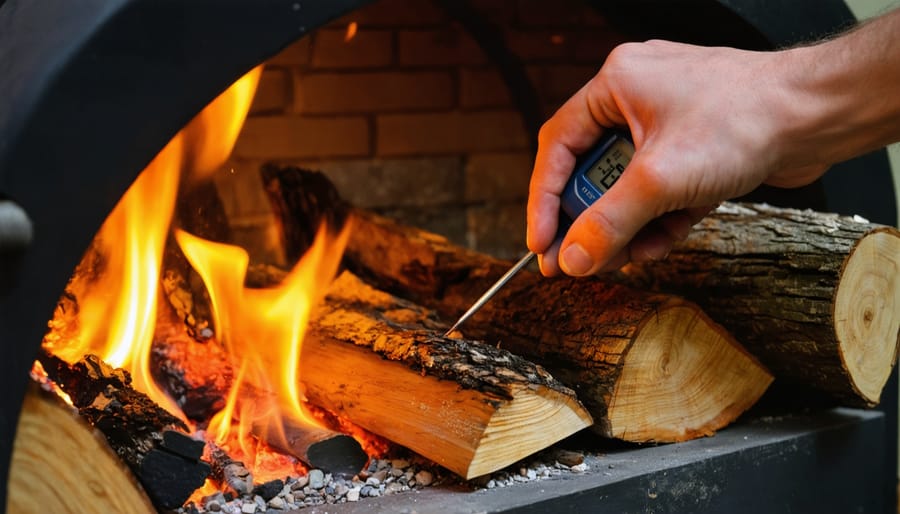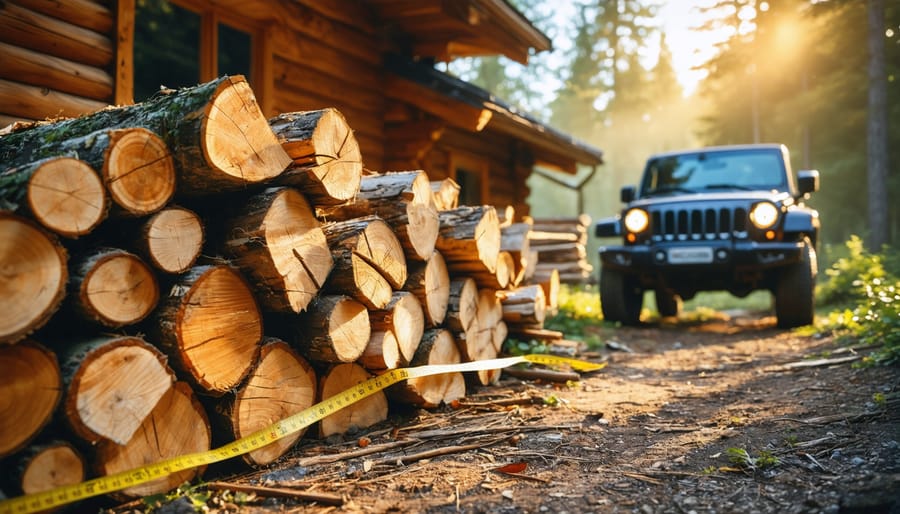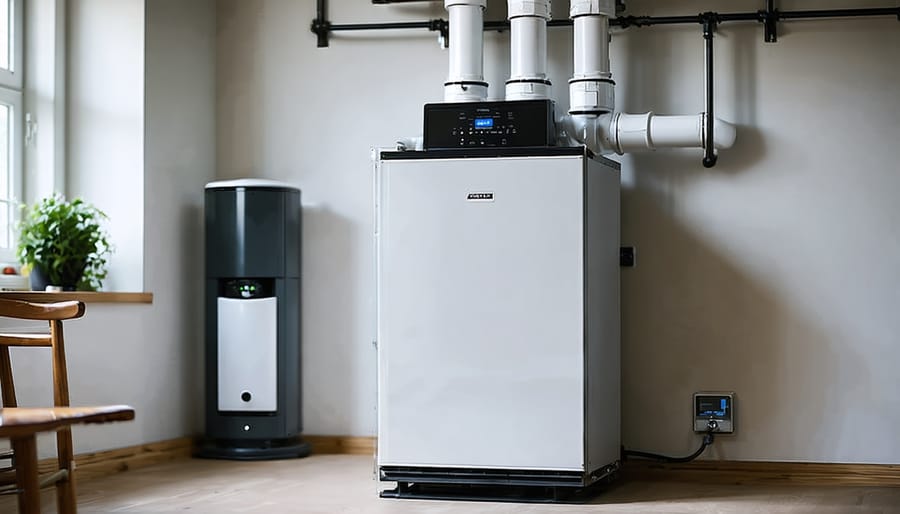**Evaluate premium fireplace fuel against standard options by examining three critical performance factors: burn time, heat output, and ash production.** Premium fuels typically burn 30-50% longer and produce significantly less creosote buildup, directly impacting both your safety and maintenance costs. Calculate your cost-per-hour of burn rather than cost-per-bundle—this reveals whether you’re actually saving money with cheaper alternatives that burn faster and require more frequent reloading.
**Test moisture content using a simple moisture meter (under $25) before purchasing any firewood.** Premium suppliers season their wood to 15-20% moisture content, while standard options often sit at 25-35%. This difference translates to more heat in your home versus smoke up your chimney, plus reduced creosote formation that threatens chimney fires.
**Consider your fireplace usage patterns when deciding if premium fuel justifies the investment.** Weekend-only users burning 4-6 hours weekly may find standard kiln-dried wood perfectly adequate. However, if you’re heating your home regularly throughout winter or prioritizing minimal smoke for health and environmental reasons, premium options deliver measurable benefits. The cleanest-burning fuels produce 60-80% less particulate emissions—a significant factor for both indoor air quality and your neighborhood’s environment.
**Match fuel type to your specific fireplace system.** Gas inserts, traditional wood-burning fireplaces, and modern EPA-certified stoves each perform optimally with different fuel characteristics, making “premium” a relative term based on your setup.
What Actually Makes Fireplace Fuel ‘Premium’
The Science Behind Clean Burns
Think of your fireplace like a car engine – the quality of fuel you use directly impacts performance. When premium fireplace fuel burns, it’s all about the moisture content and density working together to create what experts call a “complete combustion.”
Here’s what happens: High-quality, properly seasoned wood or manufactured logs contain less moisture (typically under 20%), which means the fire doesn’t waste energy evaporating water. Instead, that energy goes straight into producing heat for your home. You’ll notice the difference immediately – cleaner flames with less smoke billowing back into your room.
Lower-quality fuels with high moisture content produce incomplete combustion. The wood smolders rather than burns efficiently, creating more creosote (that sticky, tar-like substance in your chimney) and releasing unnecessary smoke into the environment. It’s not just wasteful; it’s also harder on your chimney and the air quality around your home.
Premium fuels also burn at more consistent temperatures, giving you better control over your fire and maximizing heat output per log. This means you’re actually using less fuel overall to achieve the same cozy warmth. Plus, cleaner burns produce significantly fewer particulates and emissions – a win for both your indoor air quality and the environment outside.
The bottom line? Better fuel quality means more heat, less mess, and a more eco-friendly fire that enhances your home’s ambiance without compromise.

Premium Certifications That Matter (And Ones That Don’t)
When shopping for premium fireplace fuel, legitimate certifications help separate quality products from marketing hype. Look for **EPA certification**, which ensures cleaner burning and reduced emissions—a genuine indicator of both performance and environmental responsibility. The **CSA (Canadian Standards Association)** mark verifies safety standards and consistent quality control.
For wood products, **FSC (Forest Stewardship Council)** certification matters if sustainability is important to you, confirming responsible forestry practices. Similarly, **SFI (Sustainable Forestry Initiative)** certification indicates ethical sourcing.
Be skeptical of vague claims like “premium grade” or “ultra-refined” without third-party verification. These terms sound impressive but aren’t regulated standards. “Laboratory tested” means little unless specific testing organizations are named. Proprietary “eco-ratings” created by manufacturers themselves should raise questions—genuine certifications come from independent organizations.
When comparing fuels, certifications from recognized bodies give you confidence that premium pricing reflects actual quality differences rather than clever marketing. Don’t pay extra for products relying solely on fancy packaging and unverified claims. Legitimate certifications protect both your investment and your home’s air quality.
Premium vs. Standard: The Real Performance Gap

Wood: Kiln-Dried vs. Seasoned vs. Big Box Store Bundles
Not all wood is created equal, and the difference in your fireplace experience comes down to one critical factor: moisture content. Understanding these distinctions helps you make choices that enhance both your comfort and your wallet.
**Kiln-dried wood** represents the premium tier, with moisture content below 20% (often around 15%). These logs are professionally dried in controlled environments, ensuring consistent burn quality. You’ll notice immediate ignition, minimal smoke, and sustained heat output. While the upfront cost runs higher—typically $8-12 per bundle—the efficient burn means you’ll use fewer logs per fire, ultimately improving your cost-per-burn ratio.
**Seasoned wood** offers middle-ground value when properly aged for 6-12 months. Quality seasoned wood should have 20-25% moisture content, delivering reliable performance at $5-8 per bundle. The challenge? You’re trusting the seller’s storage practices. Well-seasoned wood produces a hollow sound when struck together and shows cracked ends—signs worth checking before purchase.
**Big box store bundles** present the greatest gamble. These convenient packages often contain wood with 30-40% moisture content, creating frustrating fires with excessive smoke, poor heat output, and creosote buildup. At $4-6 per bundle, they seem economical, but you’ll burn through twice as many logs—and potentially face chimney issues down the line.
Unlike coal or charcoal alternatives, wood quality directly impacts your indoor air quality and heating efficiency. For eco-friendly heating that truly delivers warmth and ambiance, investing in properly dried wood pays dividends in comfort and safety.
Bioethanol: Lab-Grade vs. Standard Formulations
When shopping for bioethanol fireplace fuel, you’ll encounter two main categories: lab-grade (often marketed as premium) and standard formulations. The difference primarily comes down to purity levels, which significantly impact your indoor experience.
Lab-grade bioethanol typically boasts 96-99% purity, meaning fewer impurities that can create unpleasant odors or residue. Standard formulations may contain 90-95% ethanol, with the remainder being water and trace contaminants. While this might seem like a small difference, it’s noticeable in practice.
Premium bioethanol burns cleaner, producing minimal odor—just a faint, slightly sweet scent that most people find pleasant or barely notice. Standard fuel can emit a more pronounced alcohol smell, especially in smaller rooms, which may detract from your cozy ambiance.
Residue is another consideration. Higher purity fuel leaves virtually no buildup on your fireplace components, reducing maintenance and extending the life of your investment. Lower-grade options may leave slight deposits over time, requiring more frequent cleaning.
For indoor air quality, lab-grade bioethanol produces primarily water vapor and carbon dioxide—similar to burning candles. This makes it an eco-friendly heating solution that won’t compromise your home’s atmosphere. The choice ultimately depends on how frequently you use your fireplace and how sensitive you are to subtle environmental changes.
Gas: Premium Propane and Natural Gas Options
When it comes to gas fireplaces, premium fuel options might sound counterintuitive—after all, isn’t propane just propane? Not quite. Premium propane and natural gas offerings focus on consistent pressure delivery and purity levels that directly impact your fireplace’s performance.
Premium gas suppliers often incorporate specialized additive packages that help maintain clean burning and reduce moisture content, which can affect flame appearance and efficiency. These additives become particularly valuable in colder climates where standard propane might struggle with vaporization in extreme temperatures, potentially causing uneven flames or reduced heat output.
The real difference lies in consistency. Premium suppliers typically guarantee tighter quality controls and more reliable delivery pressure, ensuring your fireplace performs predictably whether it’s 20 degrees or 70 degrees outside. While the fuel itself costs marginally more, many homeowners find the improved reliability worth it—especially if you depend on your gas fireplace as a supplemental heating source during peak winter months.
For most casual users who light their fireplace occasionally for ambiance, standard gas service works perfectly fine. However, if you’re using your gas fireplace daily or live in areas with significant temperature swings, premium options offer peace of mind and noticeably better performance.
The Hidden Costs of Cheaper Fuel
Chimney Creosote and Maintenance Nightmares
Let’s talk about one of the less glamorous aspects of fireplace ownership: creosote buildup. When you burn wood that’s wet, green, or low-quality, it produces more smoke and releases volatile compounds that condense inside your chimney as a sticky, tar-like substance called creosote. This isn’t just an aesthetic issue—it’s a genuine fire hazard.
Creosote accumulates in layers, becoming increasingly flammable with each fire you light. In its most dangerous form, it hardens into a glazed coating that’s incredibly difficult to remove and can ignite at high temperatures, potentially causing a chimney fire. These fires can reach temperatures exceeding 2,000 degrees Fahrenheit, putting your entire home at risk.
Beyond safety concerns, poor-quality fuel means you’ll need professional chimney cleanings more frequently. Instead of the typical annual cleaning, you might find yourself scheduling services twice or even three times per season. At $200 to $400 per cleaning, those costs add up quickly—often exceeding what you would have spent on premium fuel in the first place. Quality fuel burns cleaner, produces less creosote, and helps protect both your family’s safety and your wallet.
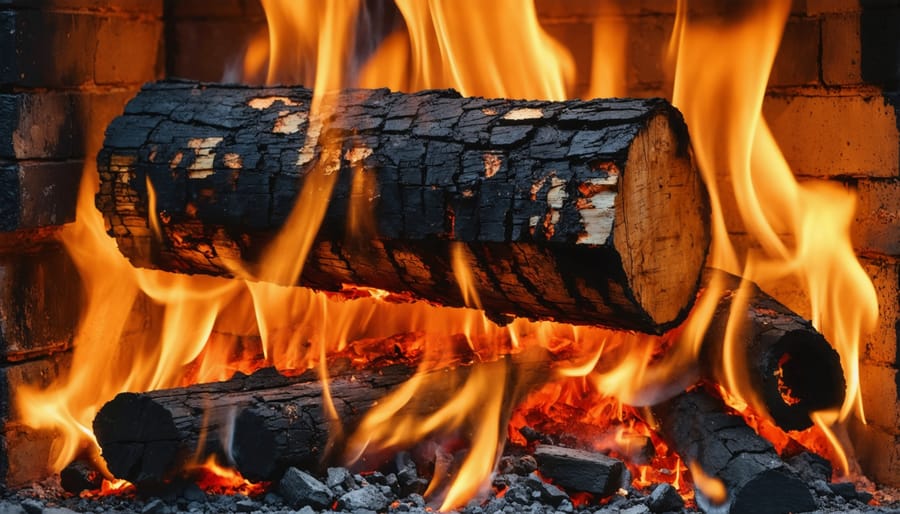
How Impure Fuels Damage Your Fireplace
Lower-grade fuels might save you money upfront, but they can quietly sabotage your fireplace’s longevity. When you burn impure fuel containing excess moisture, chemicals, or additives, you’re essentially inviting premature wear into your home’s heating system.
The most common casualty? Your fireplace’s interior components. Impure fuels produce hotter, more erratic flames that stress metal parts like grates and heat exchangers, causing warping and corrosion. The chemical residues left behind accelerate this deterioration, particularly in gas fireplace burners where even slight buildup can affect performance.
Creosote buildup becomes significantly worse with lower-quality fuels too. This tar-like substance doesn’t just create a maintenance headache—it’s a genuine fire hazard that coats your chimney walls and reduces ventilation efficiency. You’ll notice decreased heat output as deposits accumulate, forcing your system to work harder while delivering less warmth.
Glass doors and viewing panels also suffer, developing stubborn film and discoloration that obscures those beautiful flames you’re trying to enjoy. The environmental impact shouldn’t be overlooked either—impure fuels release more pollutants, contradicting the eco-friendly benefits that make fireplaces such an appealing heating choice in the first place.
The Environmental Price Tag
When it comes to environmental impact, premium fireplace fuels often justify their price tag. Higher-grade options typically produce significantly less particulate matter—those tiny particles that affect both indoor air quality and outdoor pollution. Premium fuels burn more completely, releasing fewer harmful emissions and reducing the smoke that drifts into your neighborhood.
The carbon footprint difference is real, too. Cleaner-burning fuels mean less creosote buildup in your chimney and fewer pollutants entering the atmosphere. While standard fuels might save you money upfront, they often leave behind more ash and unburned material, essentially wasting energy and creating more environmental waste. For environmentally-conscious homeowners, premium options align better with sustainable living goals, transforming your cozy fireside evenings into a more responsible heating choice that benefits both your family’s health and the wider community.
When Premium Fuel Is Worth Every Penny
Not every fireplace owner needs premium fuel, but certain situations make it absolutely worth the investment. Let’s explore when splurging on higher-quality options makes practical and financial sense for your home.
**You’re a frequent burner.** If your fireplace is more than just occasional weekend decoration—if it’s your go-to source of ambiance on chilly evenings or even supplemental heat throughout the season—premium fuel pays for itself quickly. The longer burn times mean fewer refills during those cozy evenings, and the cleaner combustion translates to less maintenance over time. When you’re burning several nights a week, the cost difference becomes negligible compared to the convenience and performance benefits you’ll enjoy.
**Your appliance is high-efficiency or ventless.** Modern, high-efficiency fireplaces and ventless models are engineered to deliver optimal performance, but they’re also more sensitive to fuel quality. These sophisticated systems can actually be compromised by lower-grade fuels that produce excessive residue or incomplete combustion. Think of it like putting regular gas in a sports car designed for premium—you’re not getting what you paid for from your fireplace investment. Premium fuel ensures your appliance operates as the manufacturer intended, protecting your investment while delivering the efficiency you purchased it for.
**Health and air quality matter to you.** Families with respiratory sensitivities, young children, or elderly members particularly benefit from premium fuels’ cleaner burn characteristics. The reduced smoke, fewer particulates, and minimal odor make a noticeable difference in indoor air quality. If anyone in your household has asthma, allergies, or other breathing concerns, the health benefits alone justify the modest price difference.
**Aesthetics are a priority.** When your fireplace serves as a focal point for entertaining or creates the ambiance that makes your house feel like home, premium fuel delivers the visual experience you’re after—steady, beautiful flames without the smoke, soot, or unpleasant smells that can detract from those special moments.
When You Can Skip the Premium Option
Let’s be honest—premium fireplace fuel isn’t always necessary, and there’s absolutely no shame in choosing standard options when they make sense for your situation. Understanding when you can confidently skip the premium price tag helps you make smart, budget-conscious decisions without sacrificing comfort or enjoyment.
If you’re using your fireplace occasionally—perhaps a few cozy evenings during the coldest months or special gatherings—standard fuel performs beautifully. The enhanced burn time and reduced ash production that premium fuels offer won’t significantly impact your experience when you’re only lighting fires sporadically. You’ll still get that wonderful warmth and ambiance without the extra investment.
Outdoor fire pits are another excellent candidate for standard fuel. Since you’re burning in open air where smoke disperses naturally and aesthetics matter less than indoor settings, the benefits of premium fuel become less noticeable. Your backyard gatherings will be just as memorable, and you can allocate those savings toward s’mores supplies instead.
Budget constraints are a completely valid reason to choose standard fuel. Home maintenance involves countless expenses, and prioritizing where your dollars go matters. Standard fuel options, including various alternative fuels, meet safety standards and provide reliable performance. You’re not compromising your family’s comfort—you’re making a practical financial choice.
If you’re new to fireplace ownership and still learning your usage patterns, starting with standard fuel makes perfect sense. You can always upgrade later once you’ve established how frequently you use your fireplace and what aspects matter most to your household. There’s wisdom in starting simple and adjusting based on real experience rather than assumptions.
How to Source Quality Fuel Without Overpaying
Finding Reputable Local Suppliers
Finding the right supplier can make all the difference in your fireplace experience. Start by seeking recommendations from neighbors who regularly use their fireplaces—word-of-mouth remains invaluable for identifying trusted local dealers. When vetting potential suppliers, look for established businesses with positive online reviews that specifically mention fuel quality and customer service.
Don’t hesitate to ask questions before making your first purchase. Inquire about their wood’s moisture content (it should be below 20% for seasoned hardwood), where they source their materials, and whether they offer any guarantees. Reputable dealers will happily discuss their seasoning process and provide transparency about their products.
Visit the supplier’s location if possible. Quality operations maintain organized, covered storage areas that protect fuel from moisture. The wood should smell fresh, not moldy, and show visible cracks on the ends—signs of proper seasoning.
For eco-conscious homeowners, ask about sustainable harvesting practices and whether they offer locally-sourced options to reduce transportation emissions. Premium suppliers often provide detailed information about their environmental commitments and can explain why their higher prices reflect superior quality and responsible sourcing practices that benefit both your fireplace performance and the planet.
Bulk Buying and Storage Strategies
Buying premium fireplace fuel in bulk can offer significant savings, but only if you store it properly to maintain its quality. Think of it like buying wine—the investment only pays off if you preserve what makes it special in the first place.
When purchasing larger quantities, start by calculating your seasonal needs. Most households burn through 1-2 cords of wood or equivalent fuel per winter, depending on usage patterns. Buying in bulk typically saves 15-25% compared to smaller purchases, making it worthwhile for regular fireplace users.
Storage is where many homeowners compromise their investment. Premium fuels—whether seasoned hardwood, eco-friendly logs, or manufactured options—need protection from moisture and proper ventilation. Store wood fuel at least six inches off the ground on pallets or racks, covered on top but open on sides for airflow. A well-ventilated shed or covered outdoor space works beautifully. Indoor storage near your fireplace should only hold a few days’ supply to prevent pest issues.
For manufactured premium fuels like eco-logs or pellets, keep original packaging intact and store in a climate-controlled space. Moisture is the enemy—once these products absorb humidity, they lose efficiency and burn quality.
Consider splitting larger bulk orders with neighbors or friends if storage space is limited. This maintains the cost benefits while ensuring you’re not compromising fuel quality through inadequate storage. Remember, premium fuel that’s been improperly stored performs worse than standard fuel kept in ideal conditions.
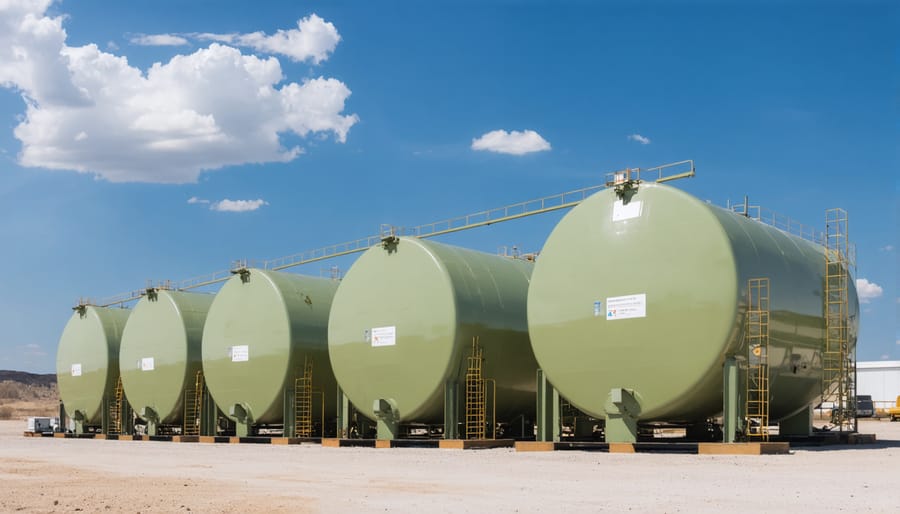
Choosing the right fireplace fuel doesn’t have to feel overwhelming. By now, you’ve explored the real differences between premium and standard options, from burn time to heat output to environmental impact. The truth is, there’s no universal “best” choice—only what works best for your unique situation and priorities.
Take a moment to calculate your own cost-per-use based on how often you actually light your fireplace. If you’re an occasional user who loves those special weekend evenings, premium fuel might deliver exactly the cleaner burn and extended warmth that makes the experience memorable. On the other hand, daily users might find that standard options provide perfectly adequate performance at a fraction of the seasonal cost.
Consider what matters most to you. Is it minimizing smoke for health reasons? Reducing your environmental footprint? Maximizing heat efficiency? Creating that picture-perfect ambiance? Your answers will guide you toward the right investment level. Just as you’ve explored other fuel comparisons, this decision deserves the same thoughtful approach.
Remember, informed choices always create better fireplace experiences. Premium doesn’t automatically mean better for everyone, and budget-friendly doesn’t mean compromise. When you align your fuel choice with your actual usage patterns and priorities, you’re making a smart investment in your home’s warmth and atmosphere. Your fireplace should enhance your lifestyle, not strain your budget or conscience. Choose wisely, burn safely, and enjoy every cozy moment.

